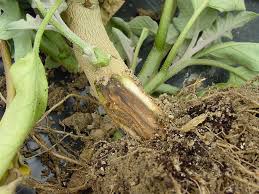Squash roots typically refers to the root system of plants belonging to the genus Cucurbita, commonly known as squashes or gourds. Cucurbita species are part of the gourd family, Cucurbitaceae, and are widely cultivated for their edible fruits and seeds. The root system of squash plants is characterized by its fibrous and spreading nature.
Squash plants have a fibrous root system, which means the roots are fine, numerous, and branching. This type of root system is efficient in absorbing nutrients and water from the soil. The squash plant initially develops a primary root, which is the first root to emerge from the seed. As the plant grows, lateral roots, or secondary roots, branch out from the primary root, forming a network of roots.
Squash plants also develop adventitious roots, which are roots that arise from non-root tissues such as stems or leaves. These roots help in stabilizing the plant and absorbing additional nutrients and water. The roots of squash plants perform essential functions, including:
Roots also store energy in the form of carbohydrates, which can be used by the plant during periods of growth or stress. Squash roots tend to spread widely in search of water and nutrients. The lateral roots extend horizontally and can cover a significant area in the soil. Understanding the structure and function of squash roots is important for successful cultivation and proper care of squash plants, ensuring optimal growth and harvest of fruits.
The Economic Importance and Uses of Squash Roots

Squash roots have economic importance and various uses, although they are not as extensively used as other parts of the squash plant like the fruit or seeds.
Here are some economic uses and importance of squash roots:
1. Food Source: Squash roots can be consumed as a food source, especially in certain cultures where they are used in traditional dishes. The roots can be cooked, boiled, or roasted and added to soups, stews, or as a side dish.
2. Medicinal Uses: Some traditional medicinal practices use squash roots for their potential medicinal properties. The roots may have properties that are believed to be beneficial for certain health issues, although scientific validation of these uses is needed.
3. Traditional Medicine: In some cultures, squash roots are used in traditional medicine to treat various ailments. They are believed to have properties that can help with digestive issues, inflammation, and other health concerns.
Read Also: Squash Leaves: Economic Importance, Uses, and By-Products
4. Nutritional Value: Squash roots contain essential nutrients, including vitamins, minerals, and dietary fiber. While not as commonly consumed as the fruit, the roots contribute to the overall nutritional value of the squash plant.
5. Animal Feed: Squash roots can be used as feed for livestock. They can be a supplementary food source, providing additional nutrients for animals like cows, sheep, or goats.
6. Composting and Soil Improvement: The organic matter from squash roots can be added to compost piles, contributing to the decomposition process and enriching the compost with essential nutrients. Additionally, when squash plants die back, the roots can decompose and enrich the soil, improving its structure and fertility.
7. Soil Erosion Control: The extensive root system of squash plants can help prevent soil erosion. The roots help bind the soil particles, reducing erosion caused by wind or water.
8. Cultural and Traditional Uses: In certain cultures, squash roots have cultural or ceremonial significance. They may be used in rituals, ceremonies, or other cultural practices as symbols of abundance or fertility.
9. Research and Study: Squash roots are also important for research and academic purposes. Scientists may study the roots to understand plant physiology, nutrient uptake, root architecture, and other botanical or agricultural aspects.
10. Potential Industrial Uses: Extracts or compounds derived from squash roots might have industrial applications. Research is ongoing to explore potential uses, such as in natural dyes, biofuels, or other industrial processes.
The Products and By-products That Can Be Derived From Squash Roots
Squash roots can be utilized to create various products and by-products, although it’s important to note that the majority of uses are not as widespread or established compared to other parts of the squash plant such as the fruit and seeds.
Here are potential products and by-products that can be derived from squash roots:
1. Squash Root Vegetable: The root itself can be harvested and used as a root vegetable in cooking. It can be boiled, roasted, or sautéed and used in stews, soups, or as a side dish.
2. Traditional Medicine: In some traditional medicinal practices, squash roots have been used for their purported medicinal properties. They are believed to have diuretic and anti-inflammatory properties and are used to treat various ailments.
3. Livestock Feed: Squash roots can be used as part of livestock feed. They can be dried and ground to create a supplemental feed for animals.
4. Compost Material: Squash roots can be added to compost piles or used as organic matter for composting, providing essential nutrients and improving soil structure.
5. Biogas Production: Squash roots, along with other organic waste, can be used to produce biogas through anaerobic digestion. The gas produced can be used for cooking or generating electricity.
6. Dye Production: Some compounds found in squash roots can be used as natural dyes for fabrics and materials.
7. Artistic Carvings: Squash roots can be carved and used for artistic purposes, similar to wood carving.
In conclusion, it is important to note that while squash roots have these potential uses, they are not as widely utilized or researched as other parts of the squash plant, such as the fruit or seeds. Additionally, ensuring sustainable harvesting practices is crucial to maintain the ecological balance and availability of squash plants in their natural habitats.
Read Also: How to Make Money from Styrofoam Recycling






